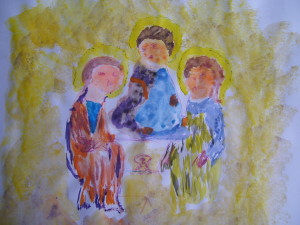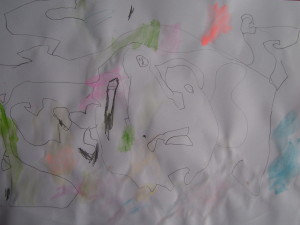How are you? We have passed the half-way point in Matthew now. How has the reading been for you? Are you finding what you expected? And any surprises? What are you finding in this rich text?
Here are this week’s readings. Then below, you will find some more Matthean things from my messy table: some photos and also an appropriate recipe…
This week’s readings:
- The Christ – Matthew ch 16
- High and Low – Matthew ch 17:1-23
- Taxation…and Freedom – Matthew ch 17:24-27
- Church Relationships – Matthew ch 18
- Family Values? – Matthew ch 19
- Kingdom Economics – Matthew ch 20:1-16
Yesterday afternoon, a bright day here with daffodils up already, a small group from my congregation at Canongate Kirk met for our Lent Event. We had two workshops – Art and Talk. Each was a space where we might discuss and explore Christ, the centre of Easter to come. The Talk group tackled Matthew – some from their readings of Leith Fisher’s commentary, others just from the gospel reading and their own interpretations. They spent a long time on the beatitudes – that sermon of sermons, full of provocations. I’d prepared a conversation hand-out for the group, but from what I could hear from the other end of the hall, the conversation met the provocations and then some! As one of the leaders in the church, it’s great to hear church members talking about these things rather than just listening as Scripture is read.
But that all comes from eavesdropping. Because I spent my afternoon at the Art table where some of the younger crowd were gathered. We were also thinking about Christ – and about the questioning call in Matthew 16: “who do you say the Son of Man is?” We used an idea from Explore and Express, using Rublev’s icon of the Trinity, and wondering together about why we talk about God as three and as one. It is a complicated and simple idea – that we know God differently, but that God is one. The icon helped with that. It is nice to think visually sometimes about complicated intellectual questions. So, we traced a template for Rublev’s three linked figures, and then set out to draw our own understanding of Jesus’ role with the Father and the Spirit. We talked about halos and wings, about water and light and the love that could feed 5000 people. We talked about God making the world and about Jesus’ love helping things grow. Blue drew lines that showed things were connected. Beangirl wanted books in her picture. One of our adults experimented with sponges and set the Trinity in a luminous cave of yellow. Here are some of our efforts.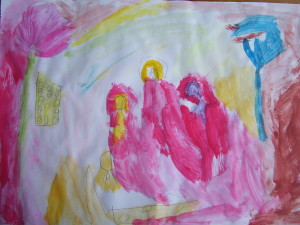
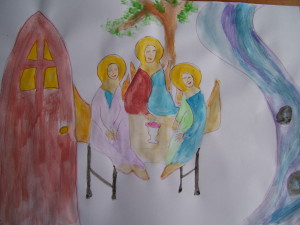
You can find more detailed instructions for this project here:
Matthew writes these words of Jesus:
“What about you?” he asked them. “Who do you say that I am?”
Simon Peter answered, “You are the Messiah, the Son of the Living God.”
“Good for you, Simon son of John!” answered Jesus. “For this truth did not come to you from any human being, but it was given to you directly from my Father in heaven.”
More rich words to ponder and explore.
And so, as promised, here’s an appropriate recipe for something else to chew on. Particularly for Evelyn, who has remarked on the richness of these texts from Matthew, – a recipe crammed with sermons worth of raisins and ideal on a March afternoon. 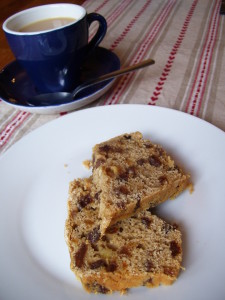
Matthean Tea Loaf: adapted from a recipe from Good Food Magazine
250 g raisins
100g mixed peel – make sure that it is citrus – it is much better
100g white sugar
40g brown sugar
300ml hot tea – nice and strong
300 g flour
1 tsp baking powder
pinch of salt
cinnamon to sprinkle
butter to grease the pan
- Mix raisins, peel and sugars in a bowl and then pour in the tea. Stir and cover, then leave to soak overnight.
- The next day, preheat the oven to 300° F. Butter a 900g loaf pan, and line the bottom with parchment paper.
- Sift flour, baking powder and salt together in a separate bowl.
- Beat the egg, stir it into fruit mixture, then mix in the dry ingredients.
- Scoop out into your prepared tin and level the surface. Sprinkle with as much cinnamon as you like, then bake for 1 ½ hours, then check with a skewer. When finished, cool for 10 minutes in the pan, then turn it out onto a cooling rack.
- Slather with butter and enjoy.
You can make ahead and freeze this loaf, but it’s hardly worth it as it is possible to make this utterly bleary-eyed. I made it half-asleep on Friday night – just a little forgiving measuring and stirring as I sipped my cup of tea – and then on Saturday morning it only needed a little more half-awake stirring and popping in the oven. The loaf baked while I breakfasted with the kids, the Spouse and the weekend newspaper, and was perfect in the afternoon when friends dropped by.

